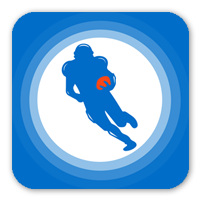In Part 2 of his series, Robert Lorge looks at several wide receivers with widely different performances from the first and second half of the 2024 NFL Season. He identifies those players, look at those splits, and pin points their cause to determine which ones are most likely to repeat in 2025.
It's not uncommon for a player to have a hot streak or a cold spell during a long season. It's the nature of the beast. What is, however, less common is when a player seemingly flips a switch and becomes a different player entirely. Sometimes, a player has two different seasons in a single year.
We'll identify three players who look like two completely different players during two separate periods of the 2024 season. These players may have started out hot and cooled off drastically, but these three players went the other way. While looking at widely different splits can be entertaining, we want to do so with a purpose. Identifying and figuring out what caused these splits can help us target and avoid certain players for the following season.
This is the second entry of a four-part series, so be sure to look for the final entries soon. You can read part one here. If you want to take advantage of our great premium tools, please use promo code "BOOM" to receive a 10% discount.
Be sure to check all of our fantasy football rankings for 2025:- 2025 fantasy football rankings (redraft)
- Dynasty fantasy football rankings
- 2025 NFL rookie fantasy football rankings
- Best ball fantasy football rankings
- Quarterback fantasy football rankings
- Running back fantasy football rankings
- Wide receiver fantasy football rankings
- Tight end fantasy football rankings
Jerry Jeudy, Cleveland Browns
You'll be lucky to find a player who had such two drastic splits in 2024 than Jerry Jeudy. His splits are so different they don't even seem believable. That's how significant the differences are. The "why" behind his splits is easy to identify. In Weeks 1-7, Jeudy had to catch passes from Deshaun Watson. For most of Weeks 8-18, Jeudy caught passes from Jameis Winston.
Consider that in Weeks 1-7, the Browns averaged 187 yards per game and 0.85 touchdowns. Cleveland's quarterbacks during this time averaged just 5.2 yards per attempt.
In Weeks 8-18, they averaged 257 yards per game and 1.3 touchdowns. The yard per attempt average increased to 6.3. Winston started and finished seven of those games. His per-game averages were 291 yards per game, 1.7 touchdowns, and 7.2 yards per attempt.
| Statistic | Weeks 1-7 | Weeks 8-18 |
| Targets (TPG) | 42 (6.0) | 103 (10.3) |
| Receptions (RPG) | 21 (3.0) | 69 (6.9) |
| Yards (YPG) | 266 (38.0) | 963 (96.3) |
| Catch Rate | 50.0% | 67.0% |
| Yards Per Target | 6.6 | 9.4 |
| Yards Per Catch | 12.7 | 14.0 |
| Target Share | 15.9% | 24.9% |
| Target Rate | 15% | 25% |
| Yards Per Route Run | 1.04 | 2.36 |
| YAC/Rec | 2.4 | 5.0 |
| Average Depth of Target | 13.6 | 10.4 |
| 1st Down Per Route Run | 5.0% | 10.8% |
| Half-PPR PPG | 6.4 | 15.1 |
There were 90 receivers to finish with at least 50 targets in 2024. His 96.3-yard-per-game average in his final 10 games of the season would have ranked second among all receivers, behind only Ja'Marr Chase.
The 38.0 yard-per-game average he had with Watson would have ranked 59th between DeAndre Hopkins and Noah Brown. His target share with Watson (15.9%) would have ranked 50th, but his 24.9% target share with Winston was 12th.
Jeudy had a 2.36-yard-per-route run average with Winston. That would have ranked 16th, tied with CeeDee Lamb. Compare that to his 1.04-yard-per-route run average with Watson, which ranked 81st, behind that of David Moore, Demarcus Robinson, and Sterling Shepard.
He averaged 15.1 half-PPR PPG with Winston, which would have been WR6 for the season, right behind Puka Nacua's 15.2 PPG average. With Watson, he averaged just 6.4. This was tied with Calvin Austin III, Diontae Johnson, and Tre Tucker.
Jeudy was on a 17-game pace of just 646 yards with Watson, but with Winston, his on-pace mark increased to 1,637. What does all of this mean for Jeudy in 2025? It's hard to say. Winston is a free agent. Watson tore his Achilles (twice). Watson seems all but guaranteed not to play in 2025, but it's unknown if Winston will return. The most likely outcome is that they have a brand new quarterback for 2025.
Could that be Kirk Cousins reuniting him with Kevin Stefanski? Could that be a rookie quarterback? Maybe Sam Darnold? However, It seems likely that Jeudy will enter the 2025 season as the Browns' undisputed No. 1 receiver. They don't have the cash to bring in a significant free agent, and they have considerable roster holes that it seems unlikely they will draft a high-ranking receiver.
Fantasy managers must wait to see what the Browns do at quarterback to determine Jeudy's value. What seems inevitable, however, is fantasy managers shouldn't be expecting a repeat of the final 10 weeks we saw with Winston under center.
Brian Thomas Jr., Jacksonville Jaguars
Thomas was a rookie last year. It's common for rookie receivers to get their feet wet, find their footing, and then take off. Throughout this series, there's commonly been one bad split and one good one. Thomas is an exception to that. Both of his splits are good. One, however, is elite. That's the difference.
In Weeks 1-10, primarily with Trevor Lawrence under center, Jacksonville averaged 30.5 attempts, 214 yards, and 1.1 touchdowns per game. From Weeks 11-18, the Jaguars averaged 34.4, 225 yards, and 1.0 touchdowns per game. For the most part, Thomas was working a similar performance from his quarterback in both data points. The most significant difference is that Lawrence's average target depth was 9.9, and Mac Jones's was 7.7. That could help explain some of the different numbers we see below.
| Statistic | Weeks 1-10 | Weeks 11-18 |
| Targets (TPG) | 56 (5.6) | 77 (11.0) |
| Receptions (RPG) | 37 (3.7) | 50 (7.1) |
| Yards (YPG) | 607 (60.7) | 675 (96.4) |
| Catch Rate | 66.1% | 64.9% |
| Yards Per Target | 11.0 | 9.1 |
| Yards Per Catch | 16.4 | 13.5 |
| Target Share | 18.0% | 30.7% |
| Target Rate | 21% | 30% |
| Yards Per Route Run | 2.35 | 2.78 |
| YAC/Rec | 6.0 | 6.7 |
| Average Depth of Target | 12.2 | 10.4 |
| 1st Down Per Route Run | 10.1% | 11.1% |
| Half-PPR PPG | 11.5 | 18.0 |
Jones's preference for shorter targets compared to Lawrence could explain the dip we see in Thomas's yards per target, yards per catch, and average target depth averages. None of the dips are overly significant. All three almost perfectly coincide with the difference between Lawrence's and Jones's target depth, which was two yards. Thomas’s yard per target average decreased by 1.9. His yards per catch went down by 2.9, and his average target depth went down by 1.8.
His targets, receptions, and yards per game show significant upgrades. Over 17 games, in Weeks 1-10, Thomas was on pace for 95 targets, 63 receptions, and 1,032 yards. From Weeks 11-18, his 17-game pace increased to 187 targets, 121 receptions, and 1,639 yards. His target share increased from 18.0% to 30.7%. Romeo Doubs had an 18.7% target share in 2024. A.J. Brown had a 31.1% target share, which ranked second, just for some perspective on how vastly different those numbers are.
Both of his yard-per-route run averages are excellent. 2.35 would have ranked 17th, but 2.78 would rank fourth. His 11.5 half-PPR PPG is similar to that of Courtland Sutton (11.3), but his 18.0 half-PPR PPG would have ranked second to only Chase's 19.9 and 1.8 half-PPR PPG better than Justin Jefferson.
Jacksonville hired Liam Coen, Tampa Bay's former offensive coordinator. He helped orchestrate a Buccaneers's offense that finished fourth in total points and third in total yards. Their passing attack ranked tenth in attempts, third in yards, and second in touchdowns. Baker Mayfield had a career season, throwing 4,500 yards and 41 touchdowns.
There should be plenty of optimism and excitement about what Coen can do with Lawrence and Thomas. Thomas should be viewed as one of the top 10 receivers going into next season. He has the potential and the upside to finish in the top five.
Ladd McConkey, Los Angeles Chargers
McConkey is another rookie like Thomas, who had two very different seasons tucked away in his first year in the NFL. What’s interesting about McConkey’s splits is that while most of his stats went up during the second half, others, ones we’d typically expect to increase with a boost in production, did not.
| Statistic | Weeks 1-6 | Weeks 7-18 |
| Targets (TPG) | 32 (6.4) | 80 (7.3) |
| Receptions (RPG) | 19 (3.8) | 63 (5.7) |
| Yards (YPG) | 219 (43.8) | 936 (85.1) |
| Catch Rate | 59.4% | 78.8% |
| Yards Per Target | 7.0 | 11.8 |
| Yards Per Catch | 11.5 | 14.9 |
| Target Share | 24.4% | 22.4% |
| Target Rate | 28% | 23% |
| Yards Per Route Run | 1.99 | 2.75 |
| YAC/Rec | 5.2 | 4.8 |
| Average Depth of Target | 9.9 | 10.3 |
| 1st Down Per Route Run | 10.9% | 11.8% |
| Half-PPR PPG | 8.7 | 15.1 |
As you can see from the chart above, while almost all of McConkey’s numbers went up in the second half, his target share and his target rate went down. It’s rare to see such a boost in production as a player gets a smaller piece of the pie. So, how did this work for McConkey?
To explain that, we need to look at Justin Herbert’s splits. In Weeks 1-6, Herbert averaged 25 pass attempts, 163 yards, and 1.2 touchdowns per game. Over 17 games, with those averages, he’d have finished with 425 pass attempts, 2,771 yards, and 20 touchdowns.
From Weeks 7-18, Herbert averaged 31.6 attempts, 255 yards, and 1.4 touchdowns. Those per-game averages would equate to 537 pass attempts, 4,328 yards, and 24 touchdowns. Those are some massive differences! We’re talking over 100 more pass attempts and 1,500 more yards!
The Chargers offense had a 50.8% pass rate in neutral game scripts in Weeks 1-6. That increased to 58.3% from Weeks 7-18. That increased volume allowed McConkey to earn less of the pie, percentage wise, but still leave with more overall targets. One thing to be cognizant of is that while his target depth between the two splits didn’t change that much (9.9 yards compared to 10.3), his catch rate did.
His catch rate increased from 59.4% to 78.8%. Herbert’s completion percentage increased from 64.0% to 66.5% between the two splits, but that doesn’t come close to explaining a 19.4-percentage increase in catch rate. His target share (24.4%), target rate (28%), and yard per route run average (1.99) early in the season foreshadowed an eventual breakout if the Chargers threw the ball more.
When they did that, fantasy managers, even the most optimistic kind, likely couldn’t have predicted what happened next. McConkey’s 2.75 yards per route run average in the second half of the season would rank in the top five, and his 15.1 half-PPR PPG average would’ve put him between Puka Nacua (15.2) and Nico Collins (14.9) at WR6.
Fantasy managers shouldn’t get too carried away with ranking McConkey as a top-10 receiver in 2025. That catch rate will surely come down. If the Chargers add another legitimate receiver, the target competition could negatively impact his target volume on an offense that still wants to run the football.
However, McConkey’s breakout cannot be ignored. He performed and scored like a top-10 receiver. Fantasy managers should be confident ranking him as a mid-WR2 with upside going into the 2025 season. The sky is bright for McConkey in LA tied to Herbert.
Download Our Free News & Alerts Mobile App
Like what you see? Download our updated fantasy football app for iPhone and Android with 24x7 player news, injury alerts, rankings, starts/sits & more. All free!






 RADIO
RADIO
























